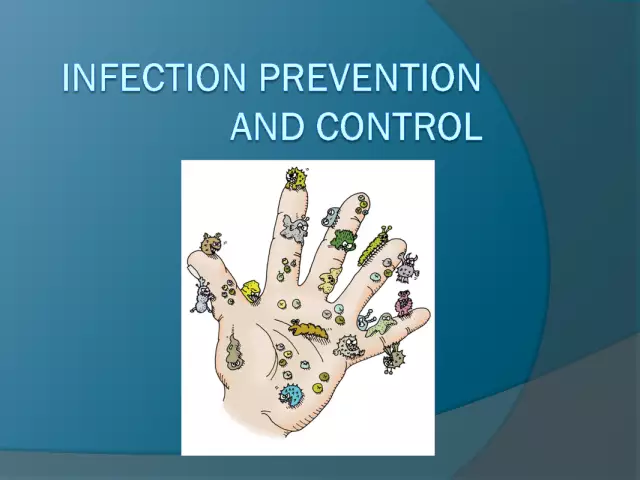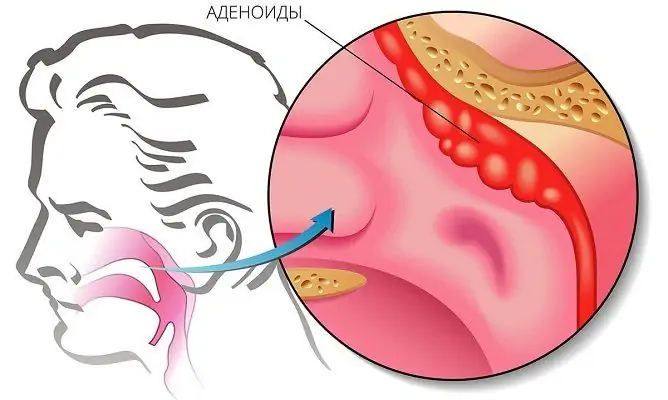- Author Rachel Wainwright [email protected].
- Public 2023-12-15 07:39.
- Last modified 2025-11-02 20:14.
Intestinal infection
The content of the article:
- Causes and risk factors
- Forms of the disease
-
Intestinal infection symptoms
- Dysentery
- Salmonellosis
- Escherichiosis
- Rotavirus infection
- Staphylococcal intestinal infection
- Diagnostics
- Intestinal infection treatment
- Potential consequences and complications
- Forecast
- Prevention of intestinal infections
Intestinal infections are a large group of infectious diseases of a bacterial and viral nature, occurring with intoxication, intestinal syndrome and dehydration. In the structure of infectious morbidity, intestinal infections rank second, second in frequency only to acute respiratory viral infections. They are much more likely to affect children than adults. Intestinal infections are especially dangerous for children in the first years of life.

Source: ogemorroe.com
Causes and risk factors
The causative agents of intestinal infection can be various pathogenic microorganisms - bacteria, protozoa, fungi and viruses. Most often, the development of the disease is caused by:
- gram-negative enterobacteriaceae (Yersinia, Escherichia, Campylobacter, Salmonella, Shigella);
- opportunistic bacteria (staphylococcus, proteus, clostridia, klebsiela);
- viruses (adenoviruses, enteroviruses, rotaviruses);
- protozoa (coccidia, amoeba, lamblia);
- mushrooms.
All pathogens of intestinal infections have enteropathogenicity and the ability to synthesize exo- and endotoxins.
The source of infection are patients with an obvious or erased clinical picture of the disease, carriers, some species of domestic animals. Infection occurs through the fecal-oral mechanism, water, alimentary (through food), contact and household (through household items, toys, dirty hands, dishes) ways.
The reason for the development of intestinal infection caused by opportunistic flora is a sharp weakening of the body's defenses, which can be caused by various reasons. As a result of this, the normal intestinal biocenosis is disrupted, which is accompanied by a decrease in the amount of normal microflora and an increase in opportunistic ones.
An important role in the development of intestinal infection is played by violations of the rules for preparing and storing food, admitting employees with streptoderma, furunculosis, tonsillitis and other infectious diseases to work at the catering facilities.
Waterborne and foodborne infections can affect large groups of the population, causing epidemic outbreaks, but isolated (sporadic) cases are much more often recorded.
The incidence of some types of intestinal infections has a pronounced seasonal dependence, for example, rotavirus gastroenteritis is more often recorded in the winter months, and dysentery in the summer.

Factors predisposing to infection are:
- non-compliance with the rules of personal hygiene;
- low acidity of gastric juice;
- poor sanitary and hygienic living conditions;
- lack of access to quality drinking water;
- intestinal dysbiosis.
Forms of the disease
The classification of intestinal infections is carried out according to the clinical and etiological principle. Most often observed in clinical practice:
- rotavirus infection;
- dysentery (shigellosis);
- escherichiosis (coli infection);
- salmonellosis;
- staphylococcal infection.
Depending on the characteristics of the symptoms (intoxication, disturbances in the water and electrolyte balance, damage to the organs of the gastrointestinal tract), the course of intestinal infection can be atypical (hypertoxic, erased) or typical (severe, moderate, mild).
Local manifestations of intestinal infections are determined by which organ of the digestive system is most involved in the pathological process. In this regard, gastritis, gastroenteritis, gastroduodenitis, duodenitis, enteritis, colitis and enterocolitis are distinguished.
In debilitated patients, intestinal infection can spread beyond the gastrointestinal tract and lead to damage to other organs and systems. In this case, they talk about the generalization of the infectious process.
By the duration of the course:
- acute intestinal infection - less than 6 weeks;
- protracted - over 6 weeks;
- chronic - the disease lasts over 6 months.
Intestinal infection symptoms
Intestinal infection, regardless of the type of pathogen, is manifested by symptoms of intoxication and damage to the gastrointestinal tract. However, some types of the disease have characteristic symptoms.
Dysentery
The incubation period lasts from 1 to 7 days. The disease begins acutely with chills and a rapid rise in temperature to 39-40 ° C. At the height of the fever, the patient may experience delirium, impaired consciousness, convulsions. Other symptoms:
- weakness;
- severe weakness;
- lack or significant decrease in appetite;
- headache;
- myalgia;
- cramping abdominal pain, localized in the left iliac region;
- spasm and soreness of the sigmoid colon;
- tenesmus (false urge to defecate);
- signs of sphincteritis;
- defecation 4 to 20 times a day.
The feces are liquid, contain an admixture of blood and mucus. With a severe course of the infectious process, hemorrhagic syndrome develops, manifested by intestinal bleeding.
The most severe course is characteristic of dysentery caused by Grigoriev's Shigella - Shiga or Flexner.
Salmonellosis
In 90% of cases, salmonellosis proceeds as gastritis, gastroenteritis or gastroenterocolitis. A subacute onset is characteristic - the temperature rises to 38-39 ° C, nausea and vomiting occur.
In some cases, the liver and spleen are enlarged (hepatosplenomegaly). Stools are frequent and plentiful, feces acquire the color of swamp mud, contain minor impurities of blood and mucus. This type of intestinal infection in adults usually ends with recovery, and in children it can become life-threatening due to rapidly developing dehydration.

Source: vancomycin.ru
Respiratory (influenza-like) form of salmonella infection is observed in 4-5% of patients. Its main symptoms are:
- febrile temperature;
- headache;
- arthralgia, myalgia;
- conjunctivitis;
- rhinitis;
- pharyngitis;
- arterial hypotension;
- tachycardia.
Typhoid-like form of salmonellosis is extremely rare (no more than 2% of all cases). It is characterized by a long period of fever (up to 1-1.5 months), dysfunctions of the cardiovascular system and severe general intoxication.
The septic form of salmonellosis is mainly diagnosed in children in the first months of life or in adult patients with severely weakened immunity (HIV infection, severe concomitant diseases). The course is extremely difficult. It is accompanied by septicopyemia or septicemia, metabolic disorders, the development of severe complications (parenchymal hepatitis, pneumonia, meningitis, otoantritis, osteomyelitis).
Escherichiosis
The largest group of intestinal infections. It combines coli infections caused by enterohemorrhagic, enteroinvasive, enterotoxigenic and enteropathogenic Escherichias.
The main symptoms of escherichiosis are:
- subfebrile or febrile body temperature;
- lethargy, weakness;
- persistent vomiting (in infants, frequent regurgitation);
- decreased appetite;
- flatulence.
Stools frequent, profuse, watery, yellowish. If the disease is caused by enterohemorrhagic Escherichia, then the feces contain an admixture of blood.
Repeated vomiting and severe diarrhea quickly lead to dehydration, the development of exicosis. Dryness of the mucous membranes and skin is noted, the elasticity and turgor of the tissues decreases, the amount of urine is reduced.
Rotavirus infection
Rotavirus intestinal infection in most cases proceeds as enteritis or gastroenteritis. The duration of the incubation period is on average 1-3 days. The disease begins acutely, its symptoms reach their maximum severity by the end of the first day. One of the main features of this form is the combination of lesions of the gastrointestinal tract with catarrhal symptoms.
Patients have:
- signs of general intoxication;
- increased body temperature;
- nausea, vomiting;
- diarrhea with a frequency of bowel movements from 4 to 15 times a day (foamy, watery stools);
- respiratory syndrome (sore throat, rhinitis, throat hyperemia, coughing).
The duration of the disease usually does not exceed 4-7 days.
Staphylococcal intestinal infection
Depending on the mechanism of infection, staphylococcal intestinal infection is of two types:
- primary - the pathogen enters the gastrointestinal tract by water or alimentary from the environment;
- secondary - staphylococci are brought into the digestive system with blood flow from any other foci of primary infection in the body.
Staphylococcal intestinal infection is quite difficult, accompanied by the development of severe toxicosis and exicosis. The stool is watery, frequent, 10-15 times a day. It is greenish in color and may contain a small amount of mucus.
Secondary staphylococcal intestinal infection in adults is extremely rare. Most often, it develops in children as a complication of acute tonsillitis, staphyloderma, pneumonia, pyelonephritis and other diseases caused by staphylococci. This form is characterized by a long undulating current.
Diagnostics
Based on clinical and epidemiological data, the results of a physical examination of the patient, it is possible to diagnose an intestinal infection and, in some cases, even suggest its type. However, establishing the exact etiological cause of the disease is possible only on the basis of the results of laboratory tests.
Bacteriological examination of feces is of the greatest diagnostic value. Material for research should be taken from the first hours of the disease, before the start of antibacterial therapy. With the development of a generalized form of intestinal infection, a bacteriological study of blood (culture for sterility), urine, cerebrospinal fluid is performed.

Source: shostka.info
Serological research methods (RSK, ELISA, RPGA) are of some value in the diagnosis of intestinal infections. They make it possible to detect the presence of antibodies to the causative agents of intestinal infection in the blood serum and thus identify them.
To clarify the localization of the pathological process in the gastrointestinal tract, a coprogram is assigned.
Differential diagnosis is carried out with biliary dyskinesia, lactase deficiency, pancreatitis, acute appendicitis and other pathology with similar symptoms. If indicated, the patient is consulted by a surgeon, gastroenterologist.
Intestinal infection treatment
The treatment regimen for intestinal infection includes the following areas:
- oral rehydration;
- health food;
- pathogenetic therapy - correction of existing dysfunctions of internal organs, increased immune reactivity and nonspecific resistance of the body, normalization of metabolism;
- etiotropic therapy - elimination of the cause that caused the development of the disease;
- symptomatic therapy - elimination of symptoms of the pathological process.
In order to correct violations of the water-electrolyte balance, oral rehydration is performed (WHO powder, Rehydron, Peditral). Glucose-saline solutions should be drunk frequently, in small sips, to prevent the onset or recurrence of vomiting. In the serious condition of the patient, when he cannot take liquid inside, infusion therapy with solutions of electrolytes and glucose is performed.
Specific therapy for intestinal infections is carried out with intestinal antiseptics and antibiotics (Nalidixic acid, Furazolidone, Polymyxin, Gentamicin, Kanamycin), enterosorbents (Activated carbon, Filtrum STI, Smecta). If indicated, immunoglobulins (antistaphylococcal, antirotavirus), lactoglobulins and bacteriophages (klebsiella, coliprotein, dysentery, salmonella and others) are prescribed.
Pathogenetic treatment of intestinal infections involves the appointment of antihistamines and enzymes.
At elevated body temperature, non-steroidal anti-inflammatory drugs are indicated. Cramping abdominal pains are relieved by taking antispasmodics.
In the acute period of the disease, a water-tea break is prescribed for 1-2 days. The diet of patients with intestinal infections is aimed at improving the digestion processes, ensuring mechanical, thermal and chemical sparing of the mucous membrane of the gastrointestinal tract. Food should be taken frequently in small portions. After the acute phenomena subsided, jelly, weak broths with white crackers, well-boiled rice, mashed potatoes, steamed meatballs are introduced into the diet.
Potential consequences and complications
Severe dehydration of the body can lead to the development of hypovolemic shock, acute renal failure. No less dangerous is the generalization of the pathological process, which can be complicated by infectious-toxic shock, sepsis, disseminated intravascular coagulation syndrome, pulmonary edema, and acute cardiovascular failure.
Forecast
In general, the prognosis for intestinal infection is favorable. It worsens with the illness of children in the first years of life, persons with immunodeficiency states and those suffering from severe concomitant pathology, as well as with an untimely start of treatment.
Prevention of intestinal infections
The basis for the prevention of intestinal infections is compliance with sanitary and hygienic standards.

Especially important:
- washing hands thoroughly after using the toilet and before eating;
- compliance with the rules for the preparation and storage of food;
- refusal to use water from unverified sources;
- thorough washing before eating vegetables and fruits;
- isolation of patients with intestinal infections;
- conducting current and final disinfection in the focus of infection.
YouTube video related to the article:

Elena Minkina Doctor anesthesiologist-resuscitator About the author
Education: graduated from the Tashkent State Medical Institute, specializing in general medicine in 1991. Repeatedly passed refresher courses.
Work experience: anesthesiologist-resuscitator of the city maternity complex, resuscitator of the hemodialysis department.
The information is generalized and provided for informational purposes only. At the first sign of illness, see your doctor. Self-medication is hazardous to health!






